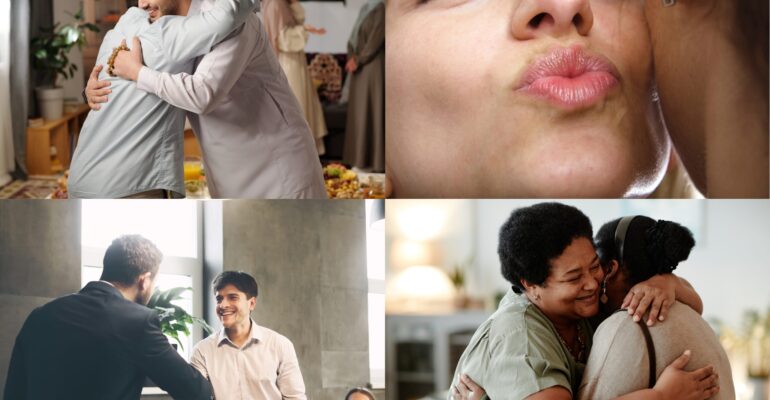First Interactions in Iran
Greetings and initial interactions in Iran are deeply rooted in cultural traditions, social norms, and Islamic customs. Unlike in many Western countries, where personal space and physical distance are highly valued, Iranians are generally warm, expressive, and physically close when interacting with others.
Physical Greetings:
- Among family members, close friends, and familiar acquaintances, it is customary to exchange kisses on the cheek; usually two, but sometimes three, depending on the region and level of closeness. These kisses are often accompanied by a warm embrace or holding hands.
- Men commonly kiss each other on the cheeks as a form of greeting, which is a sign of respect, affection, and camaraderie. Women do the same with other women.
- Public displays of affection between men and women, however, are restricted by Islamic law. In public settings, men and women who are not close relatives (mahram) are generally not allowed to shake hands or kiss. In formal or professional contexts, if a man is greeting a woman, he typically waits for her to extend her hand first. If she does not, a simple nod, a hand placed over the heart, or a verbal greeting such as salãm (peace) is considered respectful.
Personal Space:
The Western notion of “personal space” is not strongly emphasized in Iran. It is common for people to stand close together, sit very near one another, or engage in physical touch (such as holding hands or placing a hand on the shoulder) while conversing. This closeness reflects warmth and sincerity rather than intrusion.
Regional Differences:
Iran is a diverse country with many ethnic and regional groups, such as Persians, Azeris, Kurds, Arabs, Baluchis, and others. Greeting customs may vary slightly across these communities. For example, in some areas, the number of cheek kisses differs, or handshakes may be preferred over other gestures.
Topics of Conversation:
Unlike in Western cultures, where personal questions might be reserved for later conversations, Iranians may ask about marital status, age, occupation, or family background early in a relationship. These questions are not considered intrusive but rather a way to build familiarity, connection, and trust. Family ties and marital status carry significant social weight in Iranian culture, so asking about them is seen as natural.
Formal vs. Informal Settings:
- In formal or business setting, handshakes (when appropriate) and polite verbal greetings are the norm. Titles and honorifics are important, and individuals are often addressed by their family name along with “Ãghã” (Mr.) or “Khãnum” (Mrs./Ms.).
- In informal or family gatherings, greetings are much warmer, involving hugs, kisses, and affectionate gestures.
Religious Considerations:
Islamic etiquette plays a strong role in shaping greetings, especially between unrelated men and women. In more conservative environments, physical contact between genders is strictly avoided, while in more relaxed social settings (such as private homes among modern families), the rules may be observed with varying degrees of strictness.



